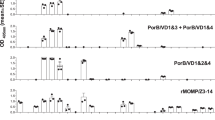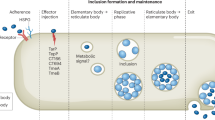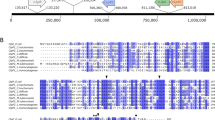Abstract
Chlamydia trachomatis, a prokaryotic obligate intracellular parasite of eukaryotic cells, has long been recognized as the agent of trachoma, the major infectious cause of human blindness1. In the past decade, clinical investigations have shown that the frequency and severity of chlamydial genital infection parallels that of gonorrhoea, and that C. trachomatis is a major cause of non-gonococcal urethritis, epidymitis, proctitis, cervicitis and salpingitis, as well as conjunctivitis and pneumonia in neonates2. Despite the new awareness of its role in human disease, there is a need for improved methods of identification and control of C. trachomatis infections. Progress in these areas awaits a more detailed understanding of the pathogenesis of chlamydial infection, including definition of key antigenic structures recognized in human disease. We have studied the immune response to chlamydial polypeptides during human infection and have found that most infected patients have antibody to polypeptides of molecular weight (Mr) 67,000 (67K), 60K, 40K, 19K and 16K, regardless of infecting immunotype3. We report here the cloning and expression in Escherichia coli of the 19K C. trachomatis polypeptide, an immunogen in human chlamydial infection.
This is a preview of subscription content, access via your institution
Access options
Subscribe to this journal
Receive 51 print issues and online access
$199.00 per year
only $3.90 per issue
Buy this article
- Purchase on Springer Link
- Instant access to full article PDF
Prices may be subject to local taxes which are calculated during checkout
Similar content being viewed by others
References
Schachter, J. New Engl. J. Med. 298, 540–549 (1978).
Holmes, K. K. J. Am. med. Assoc. 245, 1718–1723 (1981).
Wenman, W. M., Levine, M. G. & Lovett, M. A. J. infect. Dis. (submitted).
Kuo, C-C., Caldwell, H. D., Wang, S. P. & Grayston, J. T. in Nongonococcal Urethritis and Related Infections (eds Hobson, D. & Holmes, K. K.) 176–185 (Am. Soc. Microbiol., 1977).
Karn, J., Brenner, S., Barnett, L. & Cesareni, G. Proc. natn. Acad. Sci. U.S.A. 77, 5172–5176 (1980).
Blattner, F. R. et al. Science 202, 1279–1284 (1978).
Towbin, H., Staehelin, T. & Gordon, J. Proc. natn. Acad. Sci. U.S.A. 76, 4350–4354 (1979).
Author information
Authors and Affiliations
Rights and permissions
About this article
Cite this article
Wenman, W., Lovett, M. Expression in E. coli of Chlamydia trachomatis antigen recognized during human infection. Nature 296, 68–70 (1982). https://doi.org/10.1038/296068a0
Received:
Accepted:
Issue Date:
DOI: https://doi.org/10.1038/296068a0
This article is cited by
-
Expression ofChlamydia psittaci-encoded polypeptides inEscherichia coli
Current Microbiology (1987)
Comments
By submitting a comment you agree to abide by our Terms and Community Guidelines. If you find something abusive or that does not comply with our terms or guidelines please flag it as inappropriate.



